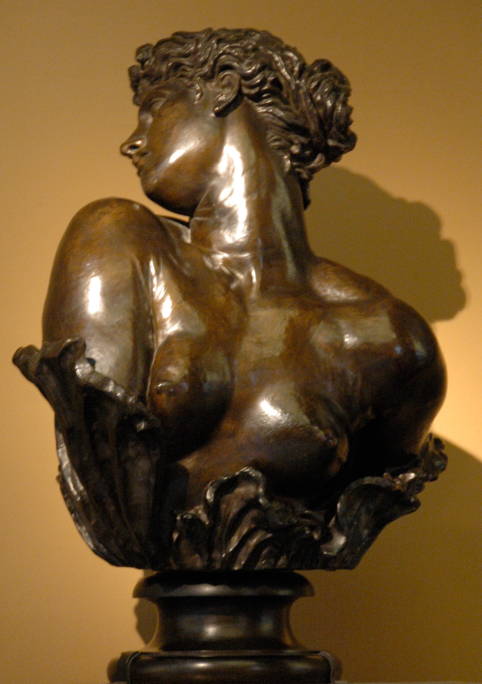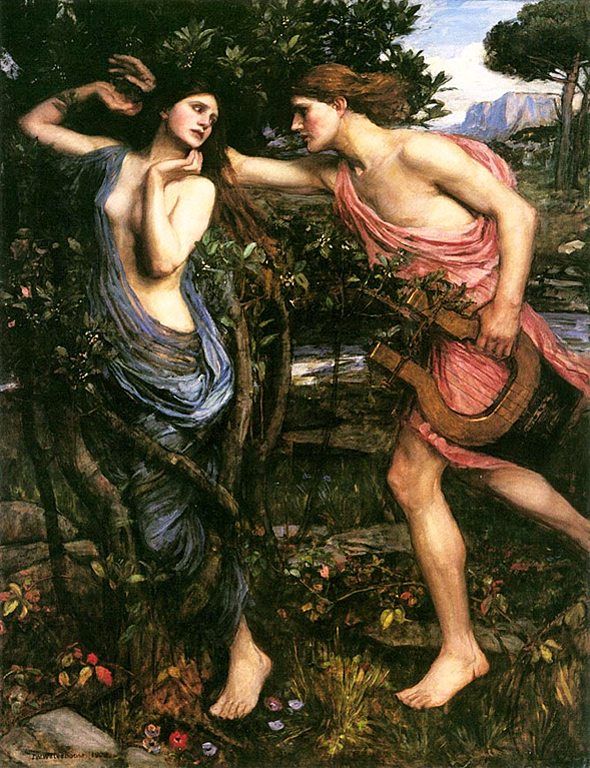“Bloom where you are planted” is an adage we’ve all probably heard, and the sentiment is a positive one: do your best no matter what your circumstances.
Clytie (above), painted by Evelyn De Morgan in the late 1880s, is perhaps an extreme example. De Morgan’s image is stunning, yet underneath that floral beauty is a darker story.
You see, she isn’t just blooming where she’s planted. She’s trapped.
A beautiful water nymph, Clytie loved the sun god Apollo. But Apollo didn’t return her affections. Stung and rejected, Clytie was unable to move on, and her love for Apollo swelled into an obsession.
Clytie remained in one spot, staring at the sun as the object of her unrequited love guided it across the sky each day in his chariot. Never eating or drinking, her only nourishment came from her own tears as she fixated on the unattainable orb.
Eventually, her legs formed roots and her face transformed into a sunflower, doomed to follow the sun’s daily arc across the sky.
She wasted away, deranged by her experience of love. Impatient of the nymphs, night and day, under the open sky, she sat dishevelled, bareheaded, on the bare earth. Without food or water, fasting, for nine days, she lived only on dew and tears, and did not stir from the ground. She only gazed at the god’s aspect as he passed, and turned her face towards him. They say that her limbs clung to the soil, and that her ghastly pallor changed part of her appearance to that of a bloodless plant: but part was reddened, and a flower hid her face. She turns, always, towards the sun; though her roots hold her fast, her love remains unaltered. (Ovid,Metamorphoses IV:256-273)
At some point in our lives, haven’t we all been Clytie? Rooted in place, unable to move on?

George Frederic Watts’ sculpture of Clytie shows the lengths to which she must contort herself to follow Apollo’s movement across the sky. Despite the physical discomfort it must have caused, she twists her head awkwardly over her shoulder.
This is not love – this is a debilitating obsession.
Myths may seem to be archaic tropes, but dust them off and there’s timeless wisdom waiting to be discovered. Clytie is a cautionary tale and the sunflower should be embraced as a symbol of what can happen when we become rooted in unhealthy ideas we can’t let go of – not growing into ourselves, but into something else completely.
Are sunflowers a symbol of Clytie’s sorrow, then? Not necessarily. I say they are symbols of hope. We can look at them and say “Not me. Not today. I am moving forward.”
Clytie, of course, is not the only myth in which a woman is transformed into a plant. Daphne, running from Apollo (yes, the same culprit), became a laurel tree.

Daphne was not interested in lovers. Ovid’s Metamorphoses tells us: “Straightaway Apollo loved, and Daphne ran even from the name of “lover”. Companion of Diana, her joy was in the depths of the forests and the spoils of the chase; a headband kept her flowing hair in place. Many suitors courted her, while she cared not for love and marriage; a virgin she roamed the pathless woods…”
She was one with the forest, enjoyed her life of nature and hunting, and was thoroughly content with her life. She was minding her own business when Apollo began to pursue her as if she were prey. But we can’t blame Apollo alone, because it was a boyish argument that sealed Daphne’s fate.
“Daphne, the daughter of Peneus, was the first object of Apollo’s love. It was not blind fate who brought this about, but Cupid’s cruel anger. Apollo, flushed with pride at his victory over Python, had seen Cupid drawing his bow and taunted him: “What business of yours are brave men’s arms, young fellow?” The bow suits my shoulder; I can take unerring aim at wild animals, or at my enemies. I it was who laid low ground Python, though he stretched over wide acres of ground, with uncounted arrows. You should be content with kindling the fires of love in some mortal with your torch; do not try to share my glory!
“To him Cupid replied: “Although your arrows pierce every target, Apollo, mine will pierce you. Just as all animals yield to you, so your glory is inferior to mine.” And as he spoke he quickly flew to the peak of shady Parnassus and from his quiver drew two arrows. Different were their functions, for the one, whose point was dull and leaden, repelled love; the other, golden, bright, and sharp aroused it. Cupid shot the leaden arrow at Peneus’ daughter (Daphne), while he pierced Apollo’s inmost heart with the golden one” (Ovid’s Metamorphosis)
Angered by Apollo’s arrogance, Cupid took his revenge by shooting Apollo with an arrow that inflamed and aroused love for Daphne, while she was pierced by an arrow that repelled feelings of love and affection.
Daphne ran. She, who was usually the hunter, had become prey.
“Even as he spoke Daphne fled from him and ran on in fear; then too she seemed lovely — the wind laid bare her body and her clothes fluttered as she ran and her hair streamed out behind. In flight she was yet more beautiful. Yet the young god could not bear to have his words of love go for nothing…”(Ovid’s Metamorphosis)
Apollo relentlessly chased her until she lost her strength, unable to go further. “Now Daphne’s strength was gone, drained by the effort of her flight, and pale she saw Peneus’ waters. “Help me Father,” she cried, “if a river has power; change me and destroy my beauty which has proved too attractive!” Hardly had she finished her prayer when her little limbs grew heavy and sluggish, thin bark enveloped her soft breasts; her hair grew into leaves, her arms into branches. Her feet, which until now had run so swiftly, held fast with clinging roots. Her face was the tree’s top; only her beauty remains.” (Ovid’s Metamorphosis)
Daphne was transformed into a laurel tree. Thus the laurel tree becomes sacred to Apollo, who wears its leaves as a crown.
Bloom where you are planted, they say. Clytie bloomed. Daphne bloomed. Yet their blossoming did not enhance their lives, and it certainly didn’t help anyone close to them. They were contained, trapped in their sunflowers and laurel tree. They were prisoners.
There is so much about life that we can’t master. Maybe we can’t control where we are or what others have done, but we are in charge of how we react, whether or not we persevere, and the attitude with which we live our lives.
Only when we realize that we have a choice – that we don’t have to be firmly rooted in place like Daphne and Clytie – does our real growth begin.
But I don’t see either woman as weak. Like Ophelia and the Lady of Shalott, I choose to see these women as symbols we can use as we navigate our own circumstances. We can draw strength from their stories; their paths can inform our own.
If I’m going to bloom where I’m planted, I’m going to be a tenacious climbing plant, unfurling my tendrils in the hopes that my attitude and actions will spread like a vine, lifting myself up, along with everyone around me.


I love this part- “There is so much about life that we can’t master. Maybe we can’t control where we are or what others have done, but we are in charge of how we react, whether or not we persevere, and the attitude with which we live our lives.” I read a fair amount of books on Stoicism and they really help my sense of peace.
Nice image. Flower is wrong though. Clytie turned into a heliotrope. Heliotrope means “turn towards the sun” which is whatvthe heliotrope is said to do. Not as spectacular a flower though. But sunflowers originate in the New World so it is doubtful that one would have formed part of an Ancient Greek myth.
Interesting! Thank you for the clarification! I appreciate the difference between the plants and, as you point out, sunflowers are not native to Ancient Greece so would not have been part of the original myth. Since sunflowers do follow the sun, I’ll still indulge myself in the symbolism and message I see in the flowers and Clytie’s tale.